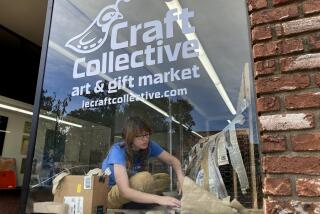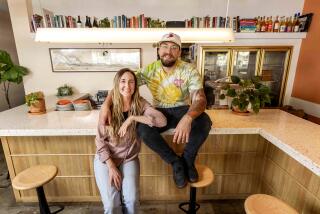Dial One Looks Alive After 8-Year Hibernation : After long dormancy and millions spent for retooling, the building trades franchiser is getting back in business.
- Share via
ORANGE — After years of near invisibility, the red, white and blue “Dial One” logo is again starting to appear around Orange County, suggesting either that hope really does spring eternal for an entrepreneur or that it’s nearly impossible to kill a good idea.
Ben Kane, entrepreneur though he is, hopes it is the latter.
Kane and his partners, after all, have pumped several million dollars--he won’t offer additional financial details--into resurrecting the building trades franchising company, which began in Long Beach in the early 1980s and had all but disappeared as that decade drew to a close.
Kane said he believes that whatever business you are in, you had better be in the service business if you want to survive. He has spent the past eight years redesigning Dial One to fit this belief--a period in which he purposely stopped selling franchises, let old ones lapse, cut out almost all marketing and concentrated on improving the internal workings of the franchise system.
His goal, he said, has been to remake the corporate franchise operation into one that recognizes that the franchisees are its customers and provides them the same level of service that franchisees are expected to provide the consumer.
Wayanne Markley, co-owner of Dial One Markley Plumbing and Heating in La Habra, said she is a believer in the changes Kane and his team have wrought.
She pays $1,500 a month to belong to the Dial One network. The specialized computer system that all Dial One franchises are hooked into, she said, saves her more than $2,250 a month in salary and benefits she otherwise would pay for a full-time sales and marketing person and an outside bookkeeping and accounting service.
The computer system, which Kane and his management designed from scratch, links each Dial One franchisee to the headquarters in Orange in an interactive system that lets franchisees and corporate management track each Dial One company’s actual performance and compare it to every similar Dial One franchise holder and to specific goals in a business plan customized for every franchisee.
The corporation also has customer service staff that calls every customer of its franchisee within days of a job’s completion, Kane said. Customers are asked to rate the quality of the job, the cost, the appearance and attitude of the franchisee’s employees and their overall satisfaction with the job. “We are able to immediately identify problems and take care of them so they aren’t repeated,” Kane said.
The computer system also lets Dial One provide franchisees with a variety of marketing and development services, such as detailed performance analyses, including time spent on each job and the volume of uncollected bills.
The original idea behind Dial One was to combine a variety of privately owned construction, repair and maintenance businesses under a single unifying logo; create a clean-cut image and reputation for prompt, friendly, honest service and then to promote the system’s convenience. Regardless of what work was needed around the house, it could be handled with a single phone call to an easily-remembered number. Hence the franchise company’s name.
The idea still makes sense, Kane said, but one that wasn’t strong enough to stand alone. Kane and his two original partners in Dial One had developed half the equation--the benefit to consumers--but hadn’t properly thought about what the individual franchise holders would get from the system.
Consequently, while franchise sales boomed at first, many dropped out after a few years, Kane said. The company opened for business in April, 1983, with 65 franchises in Orange County and Long Beach and had grown to almost 1,000 as 1984 ended. By 1986, however, the growth had stopped, the number of franchises was shrinking and Kane--who had left the corporation at the beginning of 1985--had set into play a strategy that finally is coming to fruition.
As the original vice president of sales and marketing, Kane said he found himself at odds with his partners. He wanted to concentrate on building a program to bolster the franchisees’ internal business practices; the partners wanted to concentrate on selling more franchises, which included limited classroom instruction.
A few months after leaving the company in January, 1985, Kane purchased the master franchise rights for Dial One in Orange County. He announced that he wasn’t going to sell any additional franchises in the county and would not do much advertising until he devised a way to fix what he felt was ailing the company.
Kane, a former builder and Century 21 Real Estate franchising executive, also assembled a group of financial backers who believed in his concept of a franchising company that also would serve as a business management and training resource.
By the middle of 1990, Kane and his partners owned all of Dial One’s California territories and by early 1991 they had taken over Dial One International--the original parent company--and folded everything into their new Dial One Worldwide.
More to Read
Inside the business of entertainment
The Wide Shot brings you news, analysis and insights on everything from streaming wars to production — and what it all means for the future.
You may occasionally receive promotional content from the Los Angeles Times.










